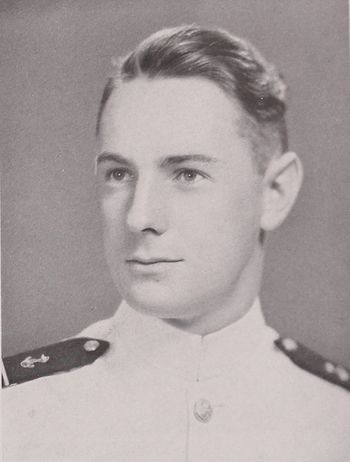ALEXANDER G. MCEWEN, LT, USN
Alexander McEwen '43
Lucky Bag
From the 1943 Lucky Bag:
ALEXANDER GRANT McEWEN
Duluth, Minnesota
Mac came to the Naval Academy as the result of a competitive examination, and thus realized a life-long ambition to become a Naval officer. Whether on Lake Superior or Chesapeake Bay, sailing has been his hobby and his principal source of real pleasure. From it has come his love for boats and the sea. Not troubled too much by his studies, he spent his spare time fencing, sailing, or sleeping, and chow and dragging formed no small part of his interests. Mac has done his share of escorting the fairer sex, and the success he has had is tacit proof of the perception of the girl back home, who charts his course.
The Class of 1943 was graduated in June 1942 due to World War II. The entirety of 2nd class (junior) year was removed from the curriculum.

ALEXANDER GRANT McEWEN
Duluth, Minnesota
Mac came to the Naval Academy as the result of a competitive examination, and thus realized a life-long ambition to become a Naval officer. Whether on Lake Superior or Chesapeake Bay, sailing has been his hobby and his principal source of real pleasure. From it has come his love for boats and the sea. Not troubled too much by his studies, he spent his spare time fencing, sailing, or sleeping, and chow and dragging formed no small part of his interests. Mac has done his share of escorting the fairer sex, and the success he has had is tacit proof of the perception of the girl back home, who charts his course.
The Class of 1943 was graduated in June 1942 due to World War II. The entirety of 2nd class (junior) year was removed from the curriculum.
Loss
Alexander was killed in action on April 2, 1945 when USS Dickerson (APD 21) was attacked and severely damaged by Japanese aircraft while off the coast of Okinawa. He was the ship's executive officer.
Other Information
From Bulletin Board of Naval Interest, (undated but apparently contemporaneous):
Battle Test for USS Dickerson, APD 21. It was 1830, April 2, 1945, and the Dickerson, high speed transport (formerly a DD by the same name), was standing approximately 15 miles west of Okinawa when she was attacked by three two-engined Jap fighters. One of the Jap planes came in to drop bombs from overhead while another roared in from dead astern to clip the number one stack, tear a gaping hole in the number two stack, then crash into the bridge, killing all personnel on the forecastle and immobilizing the forward guns. The ship was ruptured in several places, the bridge was destroyed and serious fires spread, accompanied by loud explosions.
The skipper, Lt. Cmdr. Ralph E. Lounsbury, and Lt. Alexander G. McEwen, Executive Officer, were among the 46 men and five officers lost in the engagement; 15 men were wounded. The ship carried approximately 150 officers and men. Lt. (jg) James D. Ebert, Gunnery Officer, was stationed on the flying bridge at the time of the crash. "The concussion knocked me to the deck which saved my life. Gas and flames quickly swept the bridge and well-deck causing explosions from the ready ammo boxes." Lt. (jg) Ebert and two fire-controlmen made their way down by the 20 mm platforms to the forecastle and then over the side; it was a clear day but the sea was rough and treacherous. They were later picked up by a destroyer transport.
Lt. (jg) Lafayette G. Howard, Engineering Officer, was below at his battle station in the number one engine room at the time of the crash. "It felt like we had hit bottom." No one was knocked down but smoke and sparks choked the ventilating system and the communications controls were put out of order. Lt. Howard climbed topside to find out what had happened; a damage control party was organized to fight the fire forward but it was not able to get close enough due to the intense heat. The ammunition magazine had not been flooded and could not be reached; the ship was now dead in the water and it was decided to secure and abandon her. Lt. Howard was in the water approximately half an hour with members of the after repair party before being rescued. The men were calm; several of them were slightly burned and all personnel in the engine room escaped.
William F. King, F1c, managed to launch a life boat while the ship was still doing 10 knots; the life boat was damaged and swinging from a broken davit which made the task more difficult. Fireman King did a job which normally would require five or six men. Nicholas Feasconaro, CM1c, was a member of the forward repair party; he was the senior surviving member of the party and his prompt action in combatting the raging fires was commendable. He suffered severe burns on the face and hands but continued to fight until the order was given to abandon ship. Russell S. Beach, CEM, immediately went with one group to the scene of the fire; after tireless efforts to extinguish the fire, Beach, at the order to abandon ship, led his men safely to the fantail. At 2100 the destructive fires aboard the ship were finally brought under control and she was towed to Kerama where an inspection showed her to be beyond salvage.
From researcher Kathy Franz:
Alexander's wife was Elizabeth Julia McEwen. His father Alexander was a commercial traveler for woolen goods, mother Alice, sister Audrey, and brother William.
From the Class of 1943 anniversary book "25 years later…":
Mack was born on 3 April, 1920 in Duluth, Minnesota He was appointed from Minnesota and entered the Academy on 17 July, 1939. After graduation Mack went to a series of short schools in the Norfolk area and then to the high speed destroyer transport DICKERSON in the Pacific. In January 1944 the DICKERSON participated in the landings at Green Island off the Northwest tip of Bougainville. He participated in other amphibious operations as the allies moved North in the Pacific. While engaged in the second day of the mighty Okinawa invasion, April 2, 1945, the DICKERSON was hit by enemy fire which resulted in Mack's death. He wore the Purple Heart, American Defense Service Medal with Fleet Clasp and the Asiatic-Pacific Area Campaign Medal with three bronze stars. He was survived by his wife Elizabeth Julia who at the time of Mack's death resided at 2123 Sussex Avenue, Duluth, Minnesota.
His wife was listed as next of kin.
Alexander is remembered at the Courts of the Missing in Hawaii.

The "category" links below lead to lists of related Honorees; use them to explore further the service and sacrifice of alumni in Memorial Hall.